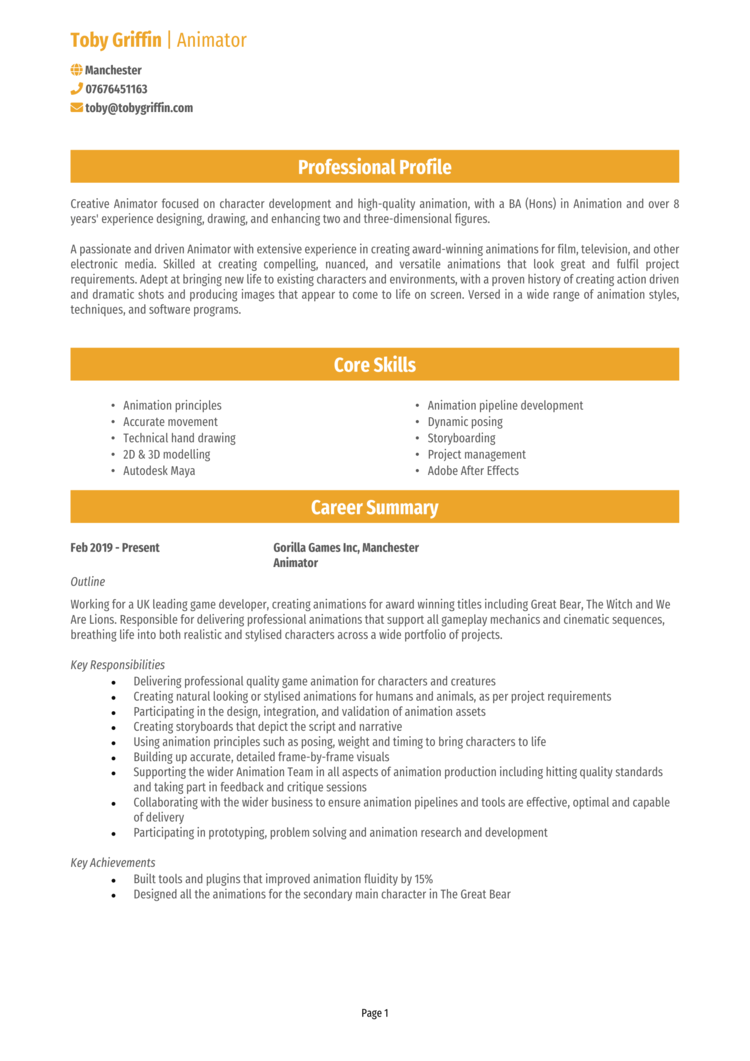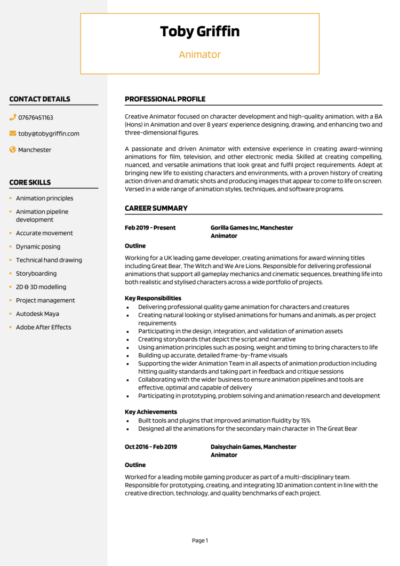Animation isn’t just about moving images – it’s about bringing imagination to life, frame by frame. Your work captivates audiences and tells compelling stories.
Employers aren’t just looking for artistic flair; they want to see precision, software expertise, and the ability to collaborate within tight production deadlines.
Use these Animator CV examples and our step-by-step writing guide to craft a CV that ensures your career moves just as smoothly as your best-rendered sequence.
Animator CV

Game Artist CV

How to write your Animator CV
Discover how to craft a winning Animator CV that lands interviews with this simple step-by-step guide.
A successful animation isn’t just about smooth motion – it’s about telling a story that captivates an audience. Your CV should do the same, making it clear why you’re the perfect fit for the role in just a few seconds.
This guide will help you with writing a CV in a way that highlights your technical skills and professional experience. Whether you’re working in gaming, film, advertising, or motion graphics, this guide ensures your CV is engaging and tailored to the industry.
What’s the right way to structure and format your Animator CV?


A well-organised and presentable CV ensures recruiters can quickly find your skills, experience, and technical expertise without unnecessary distractions. Clarity and structure matter just as much as creativity – so make sure your CV flows as well as your best animations.
Here’s the layout to follow:
- Name and contact details – Place these personal details at the top so employers can get in touch easily.
- Profile – Kick things off with a concise overview of what makes you the ideal candidate for the job.
- Core skills – Begin with the technical and artistic abilities that set you apart, such as 3D rigging, motion graphics, or character animation.
- Work experience – Start with your most recent role and work backwards, showcasing achievements and responsibilities.
- Education & certifications – Mention your degrees, certifications, and any training that supports your career path.
- Additional info – Include any additional details, like awards, professional memberships, or hobbies that highlight your skills or personality.
Your CV format should be visually clean and easy to navigate. Use bullet points for clarity, divide sections with clear headings, and stick to a professional, easy-to-read font. Keep it no longer than two pages in length – just enough to showcase your talent without losing their attention.
How to create an Animator CV profile


Your CV profile is the introduction to your skills, experience, and animation expertise. It should quickly communicate what makes you an exceptional animator and why you’re the right choice for the role. This is your first chance to hook recruiters and convince them that you’re the right fit for the role, so do it well.
Animator CV profile examples
Profile 1
Creative and detail-oriented Animator with four years of experience in 2D and 3D animation for film, television, and digital media. Skilled in character animation, motion graphics, and visual storytelling. Proficient in industry-standard software, including Adobe After Effects, Blender, and Maya. Passionate about creating engaging visuals that enhance narratives and captivate audiences.
Profile 2
Innovative 3D Animator with three years of expertise in character rigging, modelling, and motion capture animation. Skilled in creating realistic and stylised animations for video games and film productions. Proficient in Unreal Engine, Autodesk Maya, and ZBrush. Dedicated to pushing creative boundaries and delivering high-quality animations.
Profile 3
Experienced Motion Graphics Animator with over five years of expertise in designing dynamic visual content for advertising, marketing, and social media. Skilled in creating kinetic typography, special effects, and animated branding elements. Proficient in Adobe Creative Suite, Cinema 4D, and Houdini. Committed to producing compelling motion design that enhances brand storytelling.
Details to put in your Animator CV profile
Here’s some tips on what to include:
- Animation specialisation – Whether you focus on character animation, motion graphics, VFX, or 3D modeling, make it clear.
- Software expertise – Highlight your proficiency in key programs like Maya, Blender, After Effects, or Toon Boom.
- Industry experience – Mention whether you’ve worked in games, film, advertising, or corporate media.
- Creative strengths – Showcase your storytelling, timing, and ability to bring concepts to life.
- Portfolio link – Employers will want to see your work, so include a direct link to your best projects.
Presenting your core skills


Recruiters immediately start looking for keywords once they open up any CV: you should be clear about the specific and tangible software, animation techniques, and technical abilities that set you apart. Don’t make the mistake of vague, cliche soft skills.
Tailor your skills to match the job listing – whether it’s 2D or 3D animation, VFX, or motion graphics. If a role prioritises character rigging, for example, make sure that stands out, including both technical and creative skills.
Essential skills that recruiters look for in an Animator CV
- 2D and 3D Animation – Creating high-quality animations using techniques like frame-by-frame, rigging, and motion capture.
- Storyboarding and Pre-Visualization – Developing sketches and animatics to plan animation sequences and storytelling.
- Character Design and Rigging – Designing and structuring characters for smooth animation movement.
- Motion Graphics and Visual Effects – Adding dynamic elements, transitions, and visual effects using software like After Effects.
- Rendering and Compositing – Combining multiple animation layers and finalizing visuals for polished output.
- Animation Software Proficiency – Using industry-standard tools such as Adobe Animate, Blender, Maya, Cinema 4D, or Toon Boom.
- Lip Sync and Facial Animation – Matching character movements with voiceovers for realistic and expressive performances.
- Physics and Timing Principles – Applying animation fundamentals like squash-and-stretch, anticipation, and weight for realistic motion.
- Video Editing and Post-Production – Refining animated sequences with color correction, sound effects, and final touches.
- Client Collaboration and Revisions – Working with directors, clients, or studios to meet creative visions and deliver quality animations.
How to highlight work experience


Your work experience section should do more than just list jobs – it should demonstrate your ability to produce high-quality animations, work within production pipelines, and meet deadlines.
List your roles in reverse chronological order, including contract work and freelance projects if relevant. If you’ve worked in different animation fields (e.g., TV, gaming, advertising), tailor your experience to match the job you’re applying for.
If you’re newer to the industry, highlight any internships, independent projects, or coursework that showcase your animation skills.
How to make your past experience easy to read for employers

- Outline – Provide a brief introduction to the studio, company, or project you worked on.
- Responsibilities – Describe key tasks, such as rigging characters, creating animations, or collaborating with art teams. Use action words like “animated,” “designed,” and “rendered.”
- Achievements – Highlight measurable contributions, such as improving animation efficiency, creating award-winning work, or meeting tight deadlines.
Example job entries for Animators
2D Animator | Evermotion Studies
Outline
Creating engaging 2D animations for an independent animation studio, specialising in short films and digital content.
Responsibilities
- Designed and animated characters, backgrounds, and visual effects for animated productions.
- Collaborated with storyboard artists and directors to bring scripts to life.
- Used Adobe After Effects and Toon Boom Harmony to create high-quality frame-by-frame animations.
- Worked closely with sound designers to synchronise animations with dialogue and sound effects.
- Revised animations based on client and director feedback to ensure top-quality output.
Achievements
- Completed a short animated film that won an award at an international animation festival.
- Increased production efficiency by 20 percent by optimising animation workflows.
- Developed a unique animation style that became the studio’s signature look.
3D Animator | Vertex Gaming
Outline
Producing high-quality 3D animations for a video game development company, creating lifelike character movements and cinematic cutscenes.
Responsibilities
- Rigged and animated 3D characters and creatures using Maya and Blender.
- Worked with motion capture data to create realistic character movements.
- Developed in-game animations, including player actions, NPC behaviour, and combat sequences.
- Collaborated with game designers and developers to ensure seamless integration of animations.
- Created cinematic cutscenes to enhance storytelling within games.
Achievements
Optimised animation assets, reducing game loading times by 30 percent.
Created character animations that improved player immersion and engagement.
Received recognition for developing innovative animation techniques that enhanced gameplay.
Motion Graphics Animator | Luminex Agency
Outline
Designing motion graphics and visual effects for a leading creative agency, producing animations for advertising and digital marketing campaigns.
Responsibilities
- Created animated ads, title sequences, and visual effects for commercial campaigns.
- Developed motion graphics for corporate videos, social media, and promotional content.
- Used Cinema 4D and After Effects to produce engaging visual animations.
- Worked with marketing teams to translate concepts into compelling animated visuals.
- Ensured all animations were optimised for web, mobile, and broadcast formats.
Achievements
- Increased engagement rates by 40 percent by designing dynamic motion graphics for social media campaigns.
- Delivered a high-profile advertising animation that gained over one million views online.
- Recognised for producing visually stunning content that enhanced brand recognition.
Education and qualifications


Employers in the animation industry certainly value education, but practical experience and an impressive portfolio tends to be more important, so keep this section brief.
Certifications in industry-standard software can also strengthen your application, particularly for roles that require expertise in Maya, Houdini, or Unity.
If you’re self-taught but have a strong portfolio, highlight relevant training courses, workshops, or online certifications that showcase your technical expertise.
Qualifications recruiters look for in an Animator
- BA/BSc in Animation, Computer Graphics, or Digital Media – The most common qualification for professional animators.
- Adobe Certified Professional (After Effects, Premiere Pro, Animate) – Recognised certification for motion graphics and 2D animation.
- Autodesk Certified Professional (Maya, 3ds Max) – Valuable for 3D animators and VFX artists.
- Toon Boom Harmony Certification – Useful for 2D animators in TV and film.
- Unity or Unreal Engine Certification – Essential for animators working in game development.





